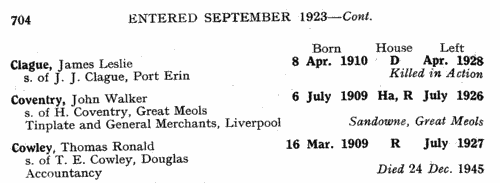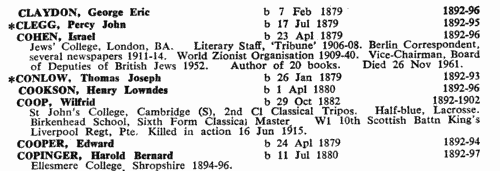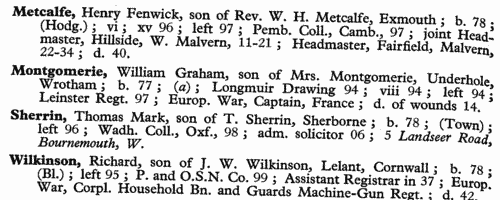Add this eBook to your basket to receive access to all 1,850 records. Our indexes include entries for the spelling barlow. In the period you have requested, we have the following 1,850 records (displaying 1,461 to 1,470): These sample scans are from the original record. You will get scans of the full pages or articles where the surname you searched for has been found. Your web browser may prevent the sample windows from opening; in this case please change your browser settings to allow pop-up windows from this site. Irish Debtors and Bankrupts
(1887)
Bills of sale (binding assets to a creditor/lender), and bankruptcies in Ireland, July to September 1887. Includes some dissolutions of partnerships. | Sample scan, click to enlarge

| Mathematics students at Cambridge University
(1887)
Tripos lists or examination results for the year, arranged by class (Wranglers, Senior Optimes and Junior Optimes), and within each class in order of score in the examination (the names of candidates with equal scores are bracketed together, with the word 'AEq.'). There is a main combined list for Parts I and II, and then, for students who went on to take Part III, a minor list, divided into Division I, Division II and Division III. Each student's surname and college is given: this list was printed in 1890, and was annotated with asterisks to show which students had subsequently become fellows of the university; and with footnotes showing those who became headmasters, &c., elsewhere. The few women students are listed separately, but the names are annotated so as to identify precisely where in order of merit they fell within the ranks of the male students. These lists are particularly useful in identifying for an individual the fellow-students who will have attended lectures with him; and, where from the college, are likely to have been even more closely associated by having been under the same supervisor. (The sample scan is from the start of the Mathematics Tripos list for 1770) | Sample scan, click to enlarge

| Partnerships Dissolved
(1887)
Dissolution of trading partnerships, or removal of a partner from a business, in England and Wales | Sample scan, click to enlarge

| Theology students at Cambridge University
(1887)
Tripos lists or examination results for the year, arranged by class (First, Second and Third), and within each class in alphabetical order. There are separate lists for Part I and Part II of the syllabus. Each student's surname and college is given: this list was printed in 1890, and was annotated with asterisks to show which students had subsequently become fellows of the university; and with footnotes showing those who became headmasters, &c., elsewhere. These lists are particularly useful in identifying for an individual the fellow-students who will have attended lectures with him; and, where from the college, are likely to have been even more closely associated by having been under the same supervisor. (The sample scan is from the start of the Mathematics Tripos list for 1770) | Sample scan, click to enlarge

| Associates of the Royal Institute of British Architects
(1888)
The Kalendar of the Royal Institure of British Architects for 1888-9 includes this list of members, corrected to 8 November 1888. It is in six parts: Honorary Fellows, Fellows, Honorary Associates, Associates, and those nominated by ballot to become Fellows and Associates. The names throughout are given in full, surname first, with current address. Those members marked * had been previously Members of Council. Members of the present Council were printed in full capitals. Those marked with a dagger were in possession of a certificate of competency to act as a District Surveyor or a Building Surveyor; those with a double dagger had passed the institute's architecture examination. (L) indicates a life member. "All gentlemen engaged in the study or practice of Architecture, before presenting themselves for election as Associates, shall be required to have passed an Examination according to a standard fixed from time to time by the Council." | Sample scan, click to enlarge

| Boys entering King William's College, Isle of Man
(1888)
King William's College at Castletown on the Isle of Man was established in 1830. By 1928 about 290 boys were being educated there, 'of whom three-fourths are boarders, and the remainders sons of natives or residents in the Island.' Boys entered the junior school about 9 or 10 years of age, the upper school about 13; boys over 13 were not admitted 'unless attainments and character are specially satisfactory'. There were 'several nominations for the sons of clergy and others'.
Editions of the college register were published in 1905 and 1927. When this third edition was prepared, in 1956, it was felt unnecessary to repeat the whole of the register from 1830 onwards, a new starting point being chosen as September 1886, when the reverend Frank Bridgman Walters took office as principal.
The items are arranged alphabetically within term of entry; surname is given first, in bold, and then full christian names; then, to the right, in bold, precise date of birth, school house, and month of leaving the school. The abbreviations for houses are: C, Colbourne; D, Dickson; H, Hunt; Ha, Hangoside; J, Junior House; R, Raglan; S, School House (formerly Principal's); T, town houses occupied by masters who took in boys prior to September 1889; Tr, Trafford's; W, Walters.
Each entry then gives the boy's father's name (surname and initials) and address at that time; school honours (such as Prae., praepositor, XI, school cricket team); a career synopsis; and finally, in italics, to the right, year of death, or present address in 1956, if known. | Sample scan, click to enlarge

| Boys entering Manchester Grammar School
(1888)
This Biographical Register of Old Mancunians lists boys alphabetically by year of entering the school. A bare register of entrants existed from 1888 onwards but it was only since the Second World War that any kind of detailed record was kept of those who passed through the school. So, in every case in this printed register, full name is given, in bold, surname first (in capitals); date of birth, and years attending the school; but for the earlier years sometimes there is no more information - or, equally, after investigation among Old Mancunians and published sources, the editors may have been able to furnish a condensed biography. An asterisk indicates a holder of a Foundation Scholarship. In the later years a current address is also given, as of 1964 to 1965, when the book was prepared. | Sample scan, click to enlarge

| Boys entering Sherborne School
(1888)
The grammar school at Sherborne in Dorset, which doubtless existed from the creation of the diocese of Sherborne in 705, was refounded by king Edward VI in 1550. At the quatercentenary in 1950, a fourth edition of the Sherborne Register was published, listing boys entering the school during those four centuries. In truth, the materials for this register survive but fitfully before 1823; for some years, no names are known; sometimes all that is known is a surname. But from 1823 onwards the lists and the details get steadily more comprehensive. By the 20th century the boys are listed alphabetically by surname under term of entrance. Surname is given in bold, then christian names, name of father (surname and initials) and address; year of birth; house (a, School House; b, Abbey House; c, The Green; d, Harper House (formerly The Retreat); f, Abbeylands; g, Lyon House; h, Westcott House); whether represented the school at cricket (xi), football (xv), shooting (viii), &c.; year of leaving; summary of degrees, career &c.; and (in italics), address as of 1950. Names in the early lists marked with an asterisk are found inscribed on the oak panelling or on the stone walls of the former schoolroom. (F) in the lists indicates a foundationer, receiving free education: after 1827, when this privilege was restricted to boys from Sherborne and neighbourhood, nearly all foundationers were day-boys. | Sample scan, click to enlarge

| Honorary Associates of the Royal Institute of British Architects
(1888)
The Kalendar of the Royal Institure of British Architects for 1888-9 includes this list of members, corrected to 8 November 1888. It is in six parts: Honorary Fellows, Fellows, Honorary Associates, Associates, and those nominated by ballot to become Fellows and Associates. The names throughout are given in full, surname first, with current address. Those members marked * had been previously Members of Council. Members of the present Council were printed in full capitals. Those marked with a dagger were in possession of a certificate of competency to act as a District Surveyor or a Building Surveyor; those with a double dagger had passed the institute's architecture examination. (L) indicates a life member. "Honorary Associates shall be persons, not following the profession of an Architect but interested in the study of Architecture, who by their connection with art or science are qualified to concur with Architects in the advancement of professional knowledge, and who are unconnected with any branch of building as a trade or business." | Sample scan, click to enlarge

| Boys entering Merchant Taylors' School in London
(1889)
Merchant Taylors' School was founded by members of the livery company of the merchant taylors of the city of London in 1561 as a grammar school. By the 19th century this was a major English public school. In 1875 the school removed from Suffolk Lane, in the City, to a new building in Charterhouse Square in Finsbury. In 1907 the Reverend William Baker, a former headmaster, published this school register for the period 1871 to 1900, which we have indexed by year of admission. Each entry gives the boy's name in full (surname, christian name(s)); date of birth; names of both parents (middle names as initials); occupation of father; career summary; and (in italics) address as of 1907. | Sample scan, click to enlarge

|
Research your ancestry, family history, genealogy and one-name study by direct access to original records and archives indexed by surname.
|











